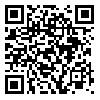Volume 4, Issue 1 (2018)
IEM 2018, 4(1): 1-4 |
Back to browse issues page
1- Bacteriology Department, Medical Sciences Faculty, Tarbiat Modares University, Tehran, Iran
2- Bacteriology Department, Medical Sciences Faculty, Tarbiat Modares University, Tehran, Iran
3- Microbiology Department, Medicine Faculty, AJA University of Medical Sciences, Tehran, Iran , bacteriology94@gmail.com
2- Bacteriology Department, Medical Sciences Faculty, Tarbiat Modares University, Tehran, Iran
3- Microbiology Department, Medicine Faculty, AJA University of Medical Sciences, Tehran, Iran , bacteriology94@gmail.com
Abstract: (6245 Views)
Aims: Many infectious diseases had traditionally been cured with herbal medicines. Antimicrobial agents are often produced synthetically to increase the food durability and quality. The purpose of this study was to determine the antimicrobial properties of the aqueous and alcoholic extracts of Allium schoenoprasum.
Materials & Methods: In this experimental study, after preparation Allium schoenoprasum samples, aqueous and alcoholic extracts were prepared and their minimum inhibitory concentration (MIC) was determined against Staphylococcus aureus, Bacillus cereus, Escherichia coli and Vibrio cholerae by micro broth dilution method. Erythromycin was used as the control.
Findings: The MIC of alcoholic and aqueous extracts of A. schoenoprasum was 16-256 and 32->256µg/ml, respectively and MBC of them were 32-256 and 64->256ug/ml, respectively. The A. schoenoprasum exhibited higher activity against S. aureus and B. cereus strains.
Conclusion: The extracts of A. schoenoprasum have antimicrobial effect on S. aureus, B. cereus, E. coli and V. cholerae strains in micro broth dilution method.
Materials & Methods: In this experimental study, after preparation Allium schoenoprasum samples, aqueous and alcoholic extracts were prepared and their minimum inhibitory concentration (MIC) was determined against Staphylococcus aureus, Bacillus cereus, Escherichia coli and Vibrio cholerae by micro broth dilution method. Erythromycin was used as the control.
Findings: The MIC of alcoholic and aqueous extracts of A. schoenoprasum was 16-256 and 32->256µg/ml, respectively and MBC of them were 32-256 and 64->256ug/ml, respectively. The A. schoenoprasum exhibited higher activity against S. aureus and B. cereus strains.
Conclusion: The extracts of A. schoenoprasum have antimicrobial effect on S. aureus, B. cereus, E. coli and V. cholerae strains in micro broth dilution method.
Keywords: Antimicrobial Agents, Allium schoenoprasum, Escherichia coli, Vibrio cholerae, Staphylococcus aureus
Subject:
Bacteriology
Received: 2017/11/27 | Accepted: 2018/02/27 | Published: 2018/05/27
Received: 2017/11/27 | Accepted: 2018/02/27 | Published: 2018/05/27
References
1. Mothana RA, Lindequist U. Antimicrobial activity of some medicinal plants of the island Soqotra. J Ethnopharmacol. 2005;96(1-2):177-81. [Link]
2. Muluye RA, Bian Y, Alemu PN. Anti-inflammatory and antimicrobial effects of heat-clearing Chinese herbs: A current review. J Tradit Complement Med. 2014;4(2):93-8. [Link] [DOI:10.4103/2225-4110.126635]
3. Tan BK, Vanitha J. Immunomodulatory and antimicrobial effects of some traditional Chinese medicinal herbs: A review. Curr Med Chem. 2004;11(11):1423-30. [Link] [DOI:10.2174/0929867043365161]
4. Ashebir M, Ashenafi M. Assessment of the antibacterial activity of some traditional medicinal plants on some food-borne pathogens. Ethiop J Health Dev. 2017;13(3):1-8. [Link]
5. Lavor AKLS, Matias EFF, Alves EF, Santos BS, Figueredo FG, Lima LF, et al. Association between drugs and herbal products: In vitro enhancement of the antibiotic activity by fractions from leaves of Croton campestris A, (Euphorbiaceae). Eur J Integr Med. 2014;6(3):301-6. [Link]
6. Gupta A, Mahajan S, Sharma R. Evaluation of antimicrobial activity of Curcuma longa rhizome extract against Staphylococcus aureus. Biotechnol Rep (Amst). 2015;6:51-5. [Link] [DOI:10.1016/j.btre.2015.02.001]
7. de Aquino PEA, Pereira NLF, Figueredo FG, Ferreira SS, Leandro LMG, Souza JCCO, et al. The association between drugs and herbal products: In vitro enhancement of the antibiotic activity by extracts of dry floral buttons of Egletes viscosa L, (macela). Eur J Integr Med. 2015;7(3):258-62. [Link]
8. Parvu AE, Parvu M, Vlase L, Miclea P, Mot AC, Silaghi-Dumitrescu R. Anti-inflammatory effects of Allium schoenoprasum L. leaves. J Physiol Pharmacol. 2014;65(2):309-15. [Link]
9. Singh V, Chauhan G, Krishan P, Shri R. Allium schoenoprasum L.: A review of phytochemistry, pharmacology and future directions. Nat Prod Res. 2017:1-15. [Link]
10. Timité G, Mitaine-Offer AC, Miyamoto T, Tanaka C, Mirjolet JF, Duchamp O, et al. Structure and cytotoxicity of steroidal glycosides from Allium schoenoprasum. Phytochemistry. 2013;88:61-6. [Link]
11. Hayrapetyan H, Hazeleger WC, Beumer RR. Inhibition of Listeria monocytogenes by pomegranate (Punica granatum) peel extract in meat paté at different temperatures. Food Control. 2012;22(1):66-72. [Link]
12. Mahon CR, Lehman DC, Manuselis G. Textbook of diagnostic microbiology-e-book. Amsterdam: Elsevier Health Sciences; 2014. [Link]
13. Baron EJ, Finegold SD. Bailey & Scott's diagnostic microbiology. Maryland Heights, Missouri: Mosby; 1990. [Link]
14. Fernandes L, Casal S, Pereira JA, Saraiva JA, Ramalhosa E. Edible flowers: A review of the nutritional, antioxidant, antimicrobial properties and effects on human health. J Food Compos Anal. 2017;60:38-50. [Link] [DOI:10.1016/j.jfca.2017.03.017]
15. Mnayer D, Fabiano-Tixier AS, Petitcolas E, Hamieh T, Nehme N, Ferrant C, et al. Chemical composition, antibacterial and antioxidant activities of six essentials oils from the Alliaceae family. Molecules. 2014;19(12):20034-53. [Link]
16. Lanzotti V, Scala F, Bonanomi G. Compounds from Allium species with cytotoxic and antimicrobial activity. Phytochem Rev. 2014;13(4):769-91. [Link] [DOI:10.1007/s11101-014-9366-0]
17. English AL, Boufridi A, Quinn R, Kurtböke D. Evaluation of fermentation conditions triggering increased antibacterial activity from a near-shore marine intertidal environment-associated Streptomyces species. Synth Syst Biotechnol. 2017;2(1):28-38. [Link] [DOI:10.1016/j.synbio.2016.09.005]
18. Gunes H, Gulen D, Mutlu R, Gumus A, Tas T, Topkaya AE. Antibacterial effects of curcumin: An in vitro minimum inhibitory concentration study. Toxicol Indust Health. 2016;32(2):246-50. [Link] [DOI:10.1177/0748233713498458]
19. Nabavi SF, Di Lorenzo A, Izadi M, Sobarzo-Sánchez E, Daglia M, Nabavi SM. Antibacterial effects of cinnamon: From farm to food, cosmetic and pharmaceutical industries. Nutrients. 2015;7(9):7729-48. [Link] [DOI:10.3390/nu7095359]
| Rights and permissions | |
 |
This work is licensed under a Creative Commons Attribution-NonCommercial 4.0 International License. |



